Vol 1 No. 42 TROPIC LIGHTNING NEWS December 9, 1966
Index
5-Minute Calls
MARS Station at Cu Chi Has Open
Lines to Pacific Islands And U.S.
“Tropic Lightning” soldiers can now call the mainland United States, Hawaii,
Japan, Okinawa, the Philippines or Guam from Cu Chi via the Military Affiliate
Radio System (MARS) station.
This division service is located directly behind the 25th Med Bn Dispensary.
It is operated by SFC Stanley A. Opsahl of Red Wing, Minn., a veteran of 19
years service assigned to Co A, 125th Sig Bn, and Sp 4 Mack C. Benton of Athens
Ga., the radio-teletype operator.
These two men operate the MARS station seven days a week during normal duty
hours. All calls going to the mainland United States are placed between 6 a.m.
and 10 a.m. daily. It is first come, first served, on stateside calls and
callers are limited to five minutes per call.
With telephone communications between Cu Chi and Hawaii it is possible to
make reservations in advance. Hawaii calls are put through from 10 a.m. - 1
p.m. Individuals in Hawaii can place calls once every two to three weeks.
It is also possible to accept incoming calls from Hawaii for personnel at Cu
Chi. Incoming calls from the United Slates are not possible because of time and
transmission difficulties.
Another service provided by the MARS station is the MARSgram.
The station’s personnel request that the grams be held to 25 words or less,
but there is no limit on the number of messages that can be sent.
| No. 1 Lt. A-OK As 2S Or 1A 1st Lt. Jesse Glasgow, 25, has been in the Army for 28 months, but although his home town of Conway S.C, is rather small, a few people haven’t got the word. Lt, Glasgow, assistant supply officer for the 2nd Bn., 9th Arty., received a letter recently from his wife Gaye, informing him that his local draft board had just reclassified him from 2-S (student deferment) to 1-A (eligible for the draft). Said his wife, “Hi’s over in Vietnam now doing all he can.” His draft board hasn’t sent any more letters. |
1/35th Guns Down 24 Cong in Week’s Action
North Vietnamese units operating in the 1st Bn., 35th Inf., area have found
the going increasingly tough. Within the last week the battalion has accounted
for 24 enemy soldiers killed and another five captured.
The battalion made contact with the enemy every day last week. Friendly
casualties were extremely light. In addition to the enemy killed, the “Cacti
Green” captured an impressive array of weapons, ammunition and other equipment.
Lt. Col. Robert Kingston, battalion commander, said that wherever his units
go, there are signs that large enemy units have pulled out of the area shortly
before.
Co A, Co B and the Reconnaissance Platoon along with Co. B of the 1st Bn,
22nd Inf, have teamed up with artillery and air strikes to keep “Charlie” on the
move.
They have found many blood trails and a great deal of enemy equipment, all of
which, according to Col. Kingston indicated that the NVA units were trying to
abandon the area.
One “Cacti Green” officer emphasized that they are now running into the
enemy’s main units, recon platoons and infantry squads, as well as support
elements. On November 25 they came across a huge bunker complex of more than
200 bunkers.
|
A Smile on The Way Home
SMILES FOR HOME - An armored personnel carrier of the 25th rumbles happily through the dusty streets of Cu Chi on the way back to base camp at the end of Operation “Attleboro.” Even the driver manages a smile. For a pictorial summary of the operation, see pages 6 & 7. |
Soldiers Respect Unique Style of Devout Gunner
Sp4 Leo D. Smith, 24, of Madisonville, Tenn., is highly thought of by the
officers and men of the 25th Division’s 1st Bn, 27th Inf, “Wolfhounds.” As a
mark of respect, Specialist Smith has been awarded the Silver Star, the nation’s
third highest award for heroism.
Modesty and consistent bravery are two of the qualities that make him one of
the best men in his unit. Deep religious conviction is what keeps him going.
Specialist Smith has a unique stance when he fires his M-60 machine gun.
Instead of lying down behind the gun, he stands up on his knees and fires from
the hip. He has never even considered firing any other way. When asked why he
chooses to make a better target of himself, he replies with characteristic
modesty, “That’s the only way to fire. I’m no hero - I just do my job. If you
get him before he gets you, you’ve got it made.”
On the question of luck, Specialist Smith has a scorn inbred by a lifetime of
devout Christianity. True to his Tennessee Baptist heritage, he says, “I have a
lot of people back home praying for me. And if that doesn’t count, I just can’t
account for it.”
His friends have learned to count on his dependability. Said one, “He’s
always there taking the initiative. You know if you start to move, he’ll have
you covered. You can count on him to be there when yon need him, always moving
to the thickest action.” And everywhere you go, you hear comments like “the
best gunner in the battalion” and “the best gunner the company ever had.” Many
of the people making these evaluations are prejudiced. They owe their lives to
the young specialist’s skill and bravado.
There are two fire fights that stand out above all other in the gunner’s
memory. On July 19 he was credited with killing 16 of the enemy, knocking six
off the same machine gun emplacement.
On February 5 Specialist Smith’s company was on a sweep through a rubber
plantation when they ran into heavy automatic weapons and sniper fire. He was
then an assistant gunner but not long. His gunner was wounded severely and
Specialist Smith took over and his particular stance and skill were well known
from that day on.
“We moved from the rice paddy to a woodline where my gunner got hit real
bad. That’s when I became a gunner,” he said. “I had taken three hits already
and my sergeant said I was hit too bad and he wanted to pull me off the gun. I
told him I wasn’t that hurt and stuck with it. I took another hit later and
when the four and a half hour long fight was over, I had to be carried back.”
“There were numerous other operations and fights but the next big one came on
July 19. We had a bad day. We were surrounded by an estimated VC battalion and
they gave us three and a half hours of hard fighting. As soon as we landed, we
were mortared on the landing zones. We maneuvered up to tree line under heavy
machine gun and sniper fire but every time we tried to move they’d pin us down.
“I had to move to get a better line of fire at an enemy machine gun because
from where I was, I had to fire two or three inches over another man’s head. I
kept knocking gunners off but two more would spring up each time to take their
place. The radio was out and ammo was low. It started raining and Charlie
slacked up. Then the choppers brought in another platoon and the VC just quit.”
Specialist Smith’s platoon leader commented, “Whatever size force Charlie had
there I know they ran short of first gunners because Smith rearranged their TO&E
(table of organization and equipment). He was out there on his knees, blazing
away from the hip trying to get better targets.”
Gen. Given Silver Star
Brig. Gen. Edward H. deSaussure Jr., commanding general of the I Field
Force, Vietnam, Artillery, was recently awarded the Silver Star for his
gallantry while commanding the 196th Bde Lt Inf during Operation “Attleboro.”
During the action, Gen. deSaussure exposed himself to enemy fire when he
personally made a reconnaissance of the battle area in an effort to obtain a
clear picture of the situation and plan for future relief of his forces.
At front line command posts and in low flying helicopters the general made
first-hand observations of the fighting.
The following are excerpts from the citation accompanying Gen. deSaussure’s
award:
“Gen. deSaussure ordered his helicopter to land in a landing zone which had
been receiving heavy mortar and rifle grenade fire.
“Exposing himself to enemy fire, he moved forward for more than 20 meters
through a clearing leading to the battalion’s command post. Soon after the
general arrived the enemy made several attempts to overrun the friendly
positions, but the men of the 196th Lt Inf Bde gallantly repelled them each
time.”
“Gen. deSaussure’s personal reconnaissance under fire allowed him to obtain a
clear picture of the tactical situation. and plan for subsequent relief of the
engaged forces. Then boarding his helicopter he ordered his crew to fly at a
low altitude over the area, where he exposed himself to enemy ground fire in
order to personally supervise the action.”
“His presence and forceful leadership caused a visible strengthening of the
fighting spirit of the line soldier.”
|
Latest Reports |
| Operation | Province | Began | FC | KIA | VCC | VCS |
| Lanikai | Long An | Sept. 15 | L | 48 | 9 | 36 |
| Paul Rev. IV | Pleiku | Oct. 18 | L | 928 | 79 | 72 |
Page 2 TROPIC LIGHTNING NEWS December 9, 1966
 |
| RUSH - Men of the 1st Bn, 14th Inf, “Golden Dragons” rush a wounded member to an aid station during a recent operation in the central highlands of Vietnam. The unit is part of the 3rd Brigade Task Force. (Photo by Sgt. Michael N. Horowitz) |
Dragons Battle
Sgt. Tells of Fight
SSgt. Richard H. Johnson, 28, of East St. Louis, Ill., started out the day as
platoon sergeant, but before it was over he became the platoon leader. His
unit, the 1st Platoon of Co B, 1st Bn, 14th lnf, “Golden Dragons” was in a fire
fight recently in which the platoon leader was wounded and Sgt. Johnson assumed
command.
Most of the fire was coming from snipers who were well concealed in the thick
vegetation and in the surrounding trees. Finally, Sgt. Johnson and his men were
able to silence the enemy fire by spraying the surrounding trees and underbrush
with automatic weapons fire.
One thing which impressed the sergeant about the battle was the fine way that
his men acted under fire, especially the new men, many of whom had never been in
combat before.
| Bible-Carrying Medic By Sgt. Michael N. Horowitz Sp4 Robert L. N. Brown of Grand Rapids, Mich., is a medic, a student of the Bible, and a conscientious objector. However, to the men of the 2nd Platoon of Co A, 1st Bn, 14th Inf, (Golden Dragons) he is also a hero. In a recent enemy encounter Specialist Brown was wounded three times. The wounds in his arm, leg and back did not keep him from doing his job. “Even after he was hit he dragged five guys back from the line of fire,” said one platoon member. Another said, “He patched up the whole second platoon.” Specialist Brown carried two items in addition to his medic’s bag; his Bible and a walking stick. According to the men in the platoon, he never complained about anything and was a real morale factor for everyone. At night, he would read to the men from his Bible and then discuss what he read. As one man said, “We always felt safe with him around.” During the battle in which he was wounded, Specialist Brown was a familiar figure, running across the area treating man after man. Every time they called “medic” he was there in minutes. Even before he could reach them, his reassuring call of “Hang on in there” gave them confidence. The specialist said that he was glad that he could help as a medic. Remarked one member of the platoon, “He helped as much with that medic bag as anybody did with a weapon.” |
Surgeon Gen. Visits Bde.
Lt. Gen. Leonard D. Heaton, the Surgeon General, U.S. Army, visited the 196th
Lt Inf. Bde’s base camp at Tay Ninh recently.
Purpose of the general’s visit was to observe the U.S. Army medical
activities and to discuss matters of mutual interest. Arriving by helicopter,
the general’s first stop was at the Logistical Command’s new 45th Surgical
Hospital. He was later escorted on a tour of the hospital.
Lucky Sp4 Will Wear “Holy” Shirt
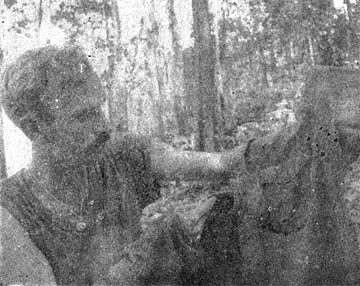 Sp4 Charles E. Carlile
Sp4 Charles E. Carlile
His favorite style is bullet-proof
Sp4 Charles E. Carlile, 24, of Collingsville, Okla., was in the midst of a
recent enemy encounter with Co A, 1st Bn, 14th Inf “Golden Dragons.”
Mortars were coming in along with grenades, small arms and automatic weapons
fire. Specialist Carlile was attempting to extract a wounded man when a mortar
round hit right where he had been moments before. His shirt was torn by mortar
and small arms fire fragments.
Sonielhow, the many wounds he received were minor scratches and burns. “I
just kept looking for holes in me,” Specialist Carlile said. He found holes in
his poncho, air mattress and pack.
His T-shirt had just one little hole in it. Specialist Carlile said that he
was going to wear that “bulletproof” shirt for the rest of his tour in Vietnam.
The action was against an estimated North Vietnamese battalion and according
to Specialist Carlile, was the roughest fighting his unit had seen since
arriving in country.
2/9th Sends Help
Yankee Teamwork Blasts NVA
As in any game or competition, it takes a team effort to score a victory. The
same holds true in war.
On November 13, artillery support was requested by Co. A, 1st Bn., 14th Inf.
The Golden Dragons had made heavy contact with an estimated NVA (North
Vietnamese Army) battalion.
Btry B of the 2nd Bn, 9th Arty, presently supporting the “Golden Dragons,”
began firing for what would be several hours, often at a feverish pace.
Co B was resting at their LZ (landing zone) at the time and seeing the hectic
pace at which the men of the “Mighty Ninth” were firing decided to lend a hand.
About 10 to 15 men helped out at each section, unloaded and opened crates of
ammunition while the artillerymen kept firing.
The men of section 3 of the Mighty Ninth Btry B were firing so fast they are
now nicknamed the “Automatic 3rd.”
As Sp4 Edmundo L. Pacbeco, a gunner for the section said, “If it wasn’t for
the infantrymen we could have never kept firing that fast.”
He went on to say “the men of the battery really appreciated their help.”
So as in any competition or conflict, it takes a team to win and it has been
proven again by the mea of the Mighty Ninth and Golden Dragons.
1/14th Contributes To Leprosy Clinic
By PFC Bryan D. Asher
The Pleiku Leprosy Clinic project got into full swing recently as Maj. James
Everard, executive officer of the 1st Bn, 14th Inf “Golden Dragons” received a
$624.54 contribution from the men in his unit.
The money was presented to Miss Olive Kingsbury, a registered nurse, who
works in a small leprosy clinic located in the Pleiku Mission Compound of the
Christian Missionary Alliance.
When the Golden Dragons discovered that Miss Kingsburg’s facilities were
limited and that there was a high degree of leprosy in Pleiku Province, they
agreed to contribute enough money to build a center for Montagnard lepers
somewhere near Pleiku City. And if all goes well it may become the first
building in a large hospital complex.
Chaplain (Maj.) Charles Pratt Jr. of the 1/14th, who suggested the project,
states that contributions will be made each month until the leprosy center
building has been raised.
Page 3 TROPIC LIGHTNING NEWS December 9, 1966
For three long hours the ambush squad lay among the wet grass and soft muck
of a roadside southwest of Saigon. The only sounds heard were animal and insect
chatterings.
Then as if from nowhere, several black-clad forms came slinking out of the
darkness and made their way toward Sgt. Daniel J. Hardman and his tiny band.
The South Bend, Ind., soldier and his three-man squad waited tensely.
This particular group of men from Co A, 4th Bn, 9th Inf, “Manchu” had made
contact with the enemy before but had never brought back a confirmed body
count. The VC had been quick to gather in their weapons and dead before. This
time “Charlie” wouldn’t get away.
As the “Manchumen” tightened their trigger fingers, the Viet Cong band
stalked closer. The bright light cast by a full moon revealed six men, some
with weapons and some without.
The distance between the groups narrowed from yards to feet and then the
night was shattered by a rapid burst of rifles firing on automatic. The squad’s
weapons spat death across the dirt road. The grenadier lobbed in a round for
good measure. As Sgt. Hardman noted, “It all happened so fast.” During the
approximately five-second fire fight only 40 bullets were expended by the
“Tropic Lightning” squad and two or three stray rounds by the VC.
Just as suddenly as the firing started, it stopped and silence returned to
the paddies. Sgt. Hardman slipped carefully over the road, returned and proudly
reported two dead Viet Cong.
The squad figured two more were hit, but no one could figure out what became
of the last two VC in the line. They just disappeared.
In the morning Sgt. Hardman spotted a body and weapon lying together in the
water of a paddy slightly off the road.
“We got another VC over here,” he yelled.
No sooner had he looked back when the body jumped up with his hands in the
air to surrender. Immediately nearby a young boy popped up with his hands
raised.
Before the American infantrymen moved out one of the group went to pick up
the Claymore mine set out during the night. To his utter shock, he found the
mine turned around.
Back to their Cu Chi base camp went a small band of happy and wiser “Manchus.”
116th Avn. Company Adds Mobility to 25th; Maj. Patterson Cmdr.
Increased air mobility, what many say to be the answer to the war in Vietnam,
has recently been added to the 25th Infantry Division.
The 116th Assault Helicopter Company has recently arrived to join the “Tropic
Lightning” Division’s multi-unit helicopter force. With its 28 UH-1 “Huey”
helicopters, the new company will work in conjunction with the combat support
mission of the 25th Avn. Bn.
The 116 Avn Co was activated in mid-July 1965 at Fort Bragg, North Carolina.
In June 1966, the 196th was redesignated the 116th Assault Helicopter Company,
at which time the company and its three detachments resided at the Phu Loi
Airfield in support of the 1st Infantry Division.
Presently under the command of Maj. James H. Patterson, the 116th is expected
to give the 25th Infantry Division added troop mobility.
4-Deucers Hurt Cong
The men of the 2nd Bn. 27th Inf, “Wolfhounds” 4.1 inch heavy mortar platoon
quickly sprang into action ready to support infantry engaged with the enemy.
The “four-deuce” platoon, assigned to Hq Hq Co consists of four mortar tubes,
each five feet long. During field operations the tubes are faced in different
directions so the crews are always ready to send the 26 pound shell crashing
into Viet Cong positions seconds after the initial fire request.
Sp4 Don Chancy said each mortar fires 40 rounds on an average night.
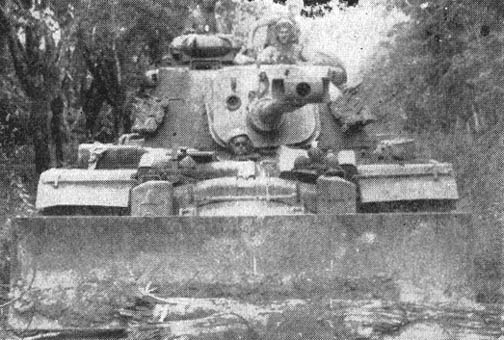 |
|
Di Di Mau |
1/5th Mech Kills 11 in War Zone C
Armored elements of the 25th clashed recently with the Viet Cong in the dense
jungles of War Zone C. killing 11 and capturing two.
Co A of the 1st Bn (Mech), 5th Inf, surprised guerrillas who were hiding in a
system of newly dug trenches and bunkers around the edge of a small used lot.
Fire from 50 caliber machine guns and salvos from M-79 grenade launchers
dominated the 20-minute battle which resulted in the 11 enemy dead and the
capture of two Chinese Communist assault rifles, a Browning automatic rifle and
a 60mm mortar of American manufacture.
Two more Viet Cong were wounded and captured when they tried to escape across
open country. The VC ignored orders to halt and the warning shots fired in the
air before being cut down by rifle fire.
VC Don’t Like Message of 7/11th
When the artillery of the 25th takes a smack at “Charlie,” the enemy gets the
message in a big way.
Ssgt. Ivan E. Taylor, intelligence sergeant for Btry A, 7th Bn, 11th Arty,
and an aerial observer pilot were recently making a routine patrol over the
Filhol Plantation, just north of the Cu Chi camp.
For three days, Viet Cong troops had been spotted moving under the trees and
along the trails of the sector. As the small OH-23 helicopter droned through
the air, Sgt. Taylor’s eyes carefully scoured the ground. And then there it
was.
Just below the chopper they saw an enemy soldier pedaling his bicycle like
mad. The Otisco, Ind., NCO was positive the VC intended to get to the
protective cover of a nearby village and hide among the people.
A lightning quick call was relayed to the “On Time” 11th and six deadly high
explosive rounds screamed into the site. All the shells slammed into the earth
directly in front of the fleeing communist. This unexpected display of
firepower caused the VC to dive for the nearest ditch, bicycle and all, but
little good it did him, for a split second after six more artillery shells made
him and his bicycle disappear.
While all this was going on the pilot of the helicopter spied movement to one
side. Banking the chopper the two men could see four VC fleeing along a trail
with the same intention as the bicycle rider, to get to the cover of the
village.
Sgt. Taylor pulled out all the stops and ordered up zone fire, which is
barrages of artillery rounds to completely cover a desired area. Btry A replied
in seconds and the black smoke of exploding munitions blanketed the target.
As the helicopter dipped low for a look, the men found three dead VC.
Sgt. Taylor said, “We knew there were more communists around somewhere so I
called in the works.”
Seventy-eight rounds later a 500-yard sector of the target area lay shattered
by blasts of flying steel. The sergeant said he saw tree tops sailing through
the air every which way. When asked about the chances of anyone living through a storm of metal such
as this, Sgt. Taylor said, “Whatever was in there didn’t stand a chance.”
 |
CONG SEEKERS - Armored Personnel Carriers of the 1st Bn (Mech), 5th Inf, criss-cross the dense jungles of War Zone C in search of Viet Cong. (Photo by PFC John Dittmann). |
Page 4 TROPIC LIGHTNING NEWS December 9, 1966
Decorated
| SILVER STAR | |
| Brig. Gen. Edward H. deSaussure Jr, HCC, 196th Lt Inf Bde. | |
| BRONZE STAR MEDAL (VALOR) |
|
|
1st Lt. Peter B. Eaton, Co B, 1st Bn, 5th Inf. 1st Lt. Richard L. Nelson, Co C, 2nd Bn, 14th Inf. Sgt. Ronald L. Losey, Co B, 1st Bn. 5th Inf. |
PFC Roger Benford, HHC, 1st Bn, 27th Inf. PFC Bruce R. Bubler, 1st Bn, 27th Inf. PFC Roy A. Love, Co B, 1st Bn, 5th Inf. |
| ARMY COMMENDATION MEDAL (VALOR) |
|
|
Maj. Roy W. Muth, HHC, 2nd Bde. Sgt. Warren A. Adams, Co A, 1st Bn, 27th Inf. Sp4 Gerald E. Ashbeck, Co C, 1st Bn, 5th Inf. Sp4 Michael B. Bollis, Co C, 1st Bn, 5th Inf. Sp4 Amadeo R. Lara Jr, Trp D, 3rd Sqdn, 4th Cav. Sp4 Nick E. Pepe, Co A, 25th Avn Bn. Sp4 Robert J. Rodgers, Co C, 1st Bn, 5th Inf. |
Sp4 Allan F. Schutter, Co C, 1st Bn, 5th Inf. Sp4 Edward Soto, Co C, 1st Bn, 5th Inf. PFC Edward S. Morris, Co B, 4th Bn, 23rd Inf. PFC John A. Scott, ‘Co C, 1st Bn, 5th Inf. PFC Kenneth J. Tally, Co C, 1st Bn, 5th Inf. PFC James Tolson, Co C, 1st Bn, 5th Inf. |
| PURPLE HEART |
|
|
1st Lt. William L. Clark, Btry C, 3rd Bn, 82nd Arty. Sgt. Jerry L. Bebault, Co A, 1st Bn, 27th Inf. Sgt. Charles C. Hooper, Co A, 1st Bn, 27th Inf. Sgt. David J. Howard, Co C, 2nd Bn, 27th Inf. Sgt. Eddie Jones, Co A, 1st Bn, 27th Inf, Sgt. Octavio Laguna, Co A, 1st Bn, 27th Inf. Sgt. Ollie N. Marshall, Co C, 1st Bn, 27th Inf. Sp4 Thurman L. Bell, Co C, 1st Bn, 5th Inf. |
Sp4 Clarence M. Bishop, Co A, 1st Bn, 27th Inf. Sp4 Andrew Gefre, Trp B, 3rd Sqdn, 4th Cav. Sp4 William P. Harnack, Co A, 1st Bn, 27th Inf. Sp4 Norman L. Howard, HHB, 1st Bn, 8th Arty. Sp4 James E. Johnson, Co C, 2nd Bn, 27th Inf. Sp4 John H. Lynch, Co A, 2nd Bn, 27th Inf. Sp4 Larry D. Manifold, Co C, 2nd Bn, 27th Inf. PFC Douglas C. Kearney, 25th Admin Co. |
Viets Build Shield of Security Behind FW Self-Help Projects
(Editor’s Note: This is the third and last in a series concerning the work of
the Free World Forces and what they are accomplishing in the Republic of
Vietnam.)
In helping the Vietnamese people rebuild their nation, the Free World Forces
have introduced many self-help projects destined to allow these people to live
and work under better conditions and protect their land and themselves from the
would-be aggressor.
The construction of necessary facilities was also undertaken, but these are
helpful only if there are funds to operate. Voluntary contributions from troops
of the free world to support hospitals, orphanages, schools, refugee camps and
the like mounted to more than 2.5 million piasters ($20,000) in June. In
August, this figure was 4.3 million piasters ($30,000). Fortunately, the
efforts of our troops have been supported by a flow of money and useful items
from organizations and individuals at home. Nation building and civic action
projects serve to help the people help themselves and will be an increasingly
important part of our military effort in Vietnam.
The war in Vietnam is far from over, but the morale of our forces is high.
The troops are the finest ever fielded. They are intelligent and well trained.
They understand the conflict and appreciate their complex role as both fighters
and builders. They welcome the opportunity to help the people of Vietnam, whom
they have come to know and admire, by creating a security shield which the
Republic of Vietnam can develop and prosper.
| CHAT - Gen. W. C. Westmoreland, Military Assistance Command, Vietnam commander, speaks to 1st Lt. Michael Moran, 23, of Kirkwood, Mo., during a recent visit to the 25th Infantry Division’s new Mines and Booby Traps School. (Photo by Spy Jose Finklea.) |
 |
Editorial
Rules For Living
When the VC recover an item of explosive ordnance which has been dropped,
launched, placed or fired by friendly forces, you can be sure that those
friendly forces will get it back.
What was once an artillery round may now be a time bomb hidden in a basket of
vegetables being delivered by an innocent looking old lady. What was once a
five 500-pound bomb may return in the form of several hundred hand grenades or
satchel charges such as those delivered to the Metropole and Victoria hotels.
The Viet Cong are quite adept when it comes to recovering any explosives
which friendly troops abandon. It therefore becomes necessary to immediately
report even the suspected existence of any explosives. In the cities, be alert,
look closely at parked vehicles in your billeting areas which contain packages
of any description.
In a recent case, a bicycle, on which was mounted a large wicker basket, was
left leaning against the wall of a billet housing American contractors.
Reported by an alert occupant of the building, the basket was found to contain
an explosive mine set up with a time device which would have detonated within
the hour. As a result of this alert American, Explosive Ordnance Detachment (
EOD ) personnel arrived in time to prevent the blast. A search of the area by
that EOD team uncovered a second bomb identical to the first, set up in front of
an American officers’ billet a block away. It too was removed without incident.
Here are some good rules for city dwellers:
1. Report the existence of any suspicious packages in any U.S. troop areas
such as offices, billets, and motor pools.
2. Maintain a safe distance if and when you should notice such a parcel.
Warn others to do the same until the item is investigated and removed by EOD
personnel.
3. Remember, explosive devices are often placed in pairs. Stay under cover
after a initial blast, there may be a second.
Allowance For U.S. Bound
Military personnel returning to the CONUS from Vietnam should make advance
arrangements for any pay they will need before reporting to their new station.
This is the advice offered by the Military Assistance Command, Vietnam, (MACV)
after receiving word that CONUS finance offices are reluctant to make casual
payment to transient personnel.
Personnel departing Vietnam may request partial or advance pay and advance
travel pay.
Partial pay includes all pay due an individual up to the date of payment. Up
to three months advance pay, exclusive of allowances and allotments may be drawn
by men with dependents and others in special circumstances.
Personnel drawing advance pay should be cautioned that their regular monthly
pay will be reduced for a six-mouth period or until the entire amount of advance
pay is refunded. Advance travel pay is the estimated pay due for travel and is
recomputed at the new duty station based on actual time and distance traveled.
Achtung!
If by the time this newspaper reaches your hands, one full day has passed
from the date of its publication (see the upper right hand corner of this page),
and still you hope to mail those gifts home in time for Christmas, you may do
so. However, you should include a note stating: DO NOT OPEN TILL XMAS 1967.
 |
| The TROPIC LIGHTNING NEWS is an
authorized publication of the 25th Infantry Division. It is published
weekly for all division units in the Republic of Vietnam by the
Information Office, 25th Infantry Division, APO U.S. Forces 96225. Army
News Features, Army Photo Features, Armed Forces Press Service and Armed
Forces News Bureau material
are used. Views and opinions expressed are not necessarily those of the
Department of the Army. Printed in Saigon, Vietnam, by The Vietnam
Guardian. Maj. Gen. Fred C. Weyand . . . . Commanding General Maj. William C. Shepard . . . . . . Information Officer 1st Lt. William H. Seely III . . . . Officer-in-Charge Sp4 David L. Kleinberg . . . . . . . Editor Sp5 Jimmy Edwards . . . . . . . . . Editorial Assistant Sp4 Adrian E. Wecer . . . . . . . . Editorial Assistant |
Page 5 TROPIC LIGHTNING NEWS December 9, 1966
105mm Boxes Used As Desks
7/11th Arty Helps Open Doors At Xom Hue Elementary School
Thanks to the men of the 7th Bn, 11th Arty, the elementary school at Xom Hue
has opened its doors to hundreds of Vietnamese youngsters in the area.
Several months ago, their education had been hindered by inadequate
educational facilities. A school house with its leaking roof, cracked walls and
floors, insufficient seating and extreme lack of study atmosphere was the
primary problem.
Looking the situation over the 25th artillerymen talked to Ngo Xuan Truong,
the village chief, and with the arrangements made, began bringing in materials
to repair the dilapidated building.
Cement from scores of bags went into patching up the walls and the floors.
New wiring fenced the perimeter. Metal sheeting covered the leaky roof. And
fresh paint made the school come alive with color. Then, a new flag pole was
erected in the courtyard with a cement square built about its base for
flag-raising ceremonies.
The task had been almost completed except for the procurement of the school
desks. Where could such desks be found to accommodate all the children? The
cannoneers decided the desks would have to be built.
More than 20 room-width desks, enough to seat 300 students, were built in the
following week from wooden 105mm ammunition boxes.
The Xom Hue elementary school was reopened during a recent ceremony in which
Lt. Col. Felix Salvador, the 7/11 battalion commander, and Truong received
thanks for their joint cooperation in the repair work. Vuong Tran An, the
Inspector of Education for Hau Nghia Province, and the teachers of the school
also expressed their sincere gratitude to all the men who devoted so much time
to the work of furnishing a suitable building for educating the future
generations of the Vietnamese people in the Xom Hue area.
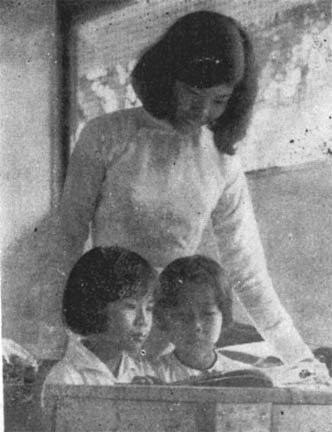 |
SCHOOL DAYS - Cao Thi Dieu, a teacher at the Xom Hue elementary school, and two of her pupils use new desks built for them by the men of the 7/11th. (Photo by Sp4 Richard Calvo) |
Cu Chi to Be Overrun By Bn. Of Santa Clauses
The 25th is, for the first time since 1953, making preparations for a
Christmas away from Hawaii.
Special Services reports that they will have many decorations of a wide
variety available to give the base camp at Cu Chi the holiday air.
More than 90 artificial Christmas trees, complete with lights, balls and
other accessories will lend hints of the Yule season to mess halls, hospital
wards, service clubs and recreation areas. A lighted tree is also planned for
the division headquarters area.
Not all decorating is expected to be done at unit level, however. Some
individual offices and billets are planning to show their Christmas spirit with
trees, wreaths, tinsel and animated figures.
Besides the lights, wreaths and tinsel that will be strung, hung and slung,
there are other plans that would ruffle the whiskers of “Old Saint Nick”
himself.
During the final hours before the joyous morn, there will be more “Santa
Clauses” scurrying around their respective areas than in an average metropolitan
department store. Each battalion-size element of the 25th, the hospitals and
service club will be allocated a “Santa” suit.
Rumor has it that many units are currently conducting research to locate
jovial volunteers that will fill the suits without the aid of pillows.
3/13th Catch VC On Noon Stroll
Even in their stronghold of the Ho Bo woods, the Viet Cong are in constant
fear of their life being taken by the ever watchful artillerymen of the
division.
Six VC, unaware that they were in danger, were crossing a clearing in the
woods when they were spotted by an artillery observer. The observer was on a
normal aerial reconnaissance flight when he saw the enemy and pinpointed their
location.
A quick radio call brought rounds thundering from the guns of the 3rd Bn,
13th Arty. When the smoke cleared two VC were dead and three VC structures were
destroyed.
The artillerymen had fired close to eight miles with deadly accuracy and
caught Charlie in the middle of an afternoon stroll.
7/11th Gets Tape Recorder
A voice from home can bring a ray of joy to a soldier serving in a far-off
land.
This is what Salvatore Quattrochi and others members of the Masonic War
Veterans Post 27, 10th Manhattan District, N.Y., had in mind when they started a
drive to send tape recorders to Vietnam.
The program originally was to send the recorders to USO clubs in Vietnam so
that the men could play tapes they had received from home and make others to
send in return.
But the program changed slightly when Mr. Quattrochi received a letter from
his son, PFC John B. Quattrochi, serving with Btry B, 7th Bn, 11th Arty. His
son’s battery has no USO club near by so the men of the Masonic Post bought the
recorder.
The gift has brought much happiness, and now the post is raising more money
and several more tape recorders will be on their way to units and USO clubs
soon.
|
|
Page 6-7 TROPIC LIGHTNING NEWS December 9, 1966
[This issue of Tropic Lightning News was scanned from a bound library volume provided by the 25th Infantry Division Museum. Two of the photographs and one full column of text on pages 6 and 7 were printed across the center of the 2-page-wide sheet and are partially hidden from sight - the book could not be safely opened wide enough to see that part of the page.]
Infantry Digs Out VC -- Attleboro – The Big One
The Battle Ends; Foe Retreats
Operation “Attleboro”, has officially ended. But those who fought in it will
perhaps never forget this bitter battle with the entrenched, determined North
Vietnamese Army (NVA) force.
The fight demanded much from the leaders and infantrymen of the 25th Division
- courage, determination, decisions, team work - to claim victories in the
battle.
[Second column of this story is hidden in the center fold of the page...]
|
Photos by Sp4 Todd Darch, PFC John Dittmann |
 |
|
Mechanized infantry moves in... |
| ... to find the enemy bunkers |
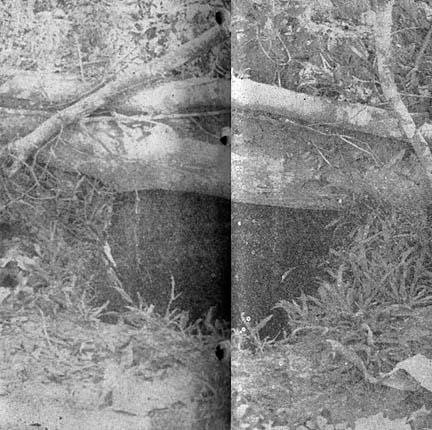 |
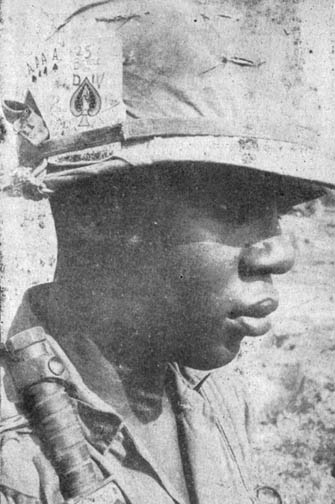 |
Bad luck for Charlie |
| Wounded enemy helped |
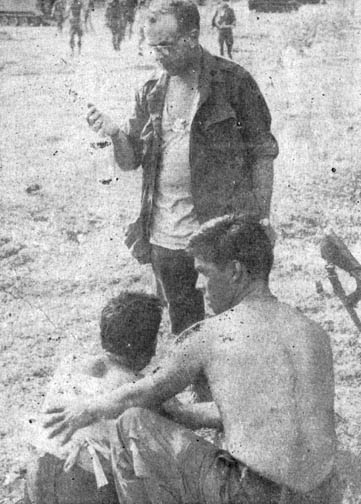 |
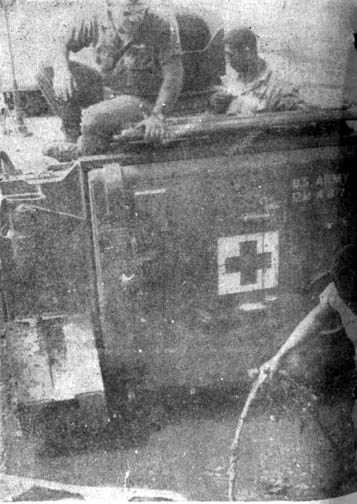 |
Thick mud slows aid |
| NVA bunker checked |
 |
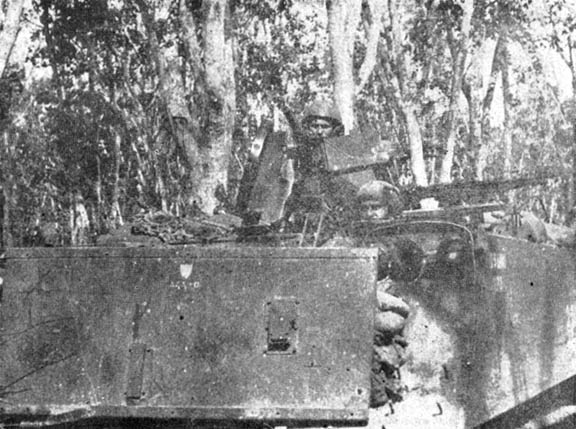 |
| ... but determined men push onward |
Page 8 TROPIC LIGHTNING NEWS December 9, 1966
‘PsyOps’ Try to Reach 2 Audiences
By Sgt. Bill Becker
 The sun had hardly risen over the village of Trang Bang when an American
helicopter roared past slightly higher than tree-top level and spilled out a
stomach full of paper squares.
The sun had hardly risen over the village of Trang Bang when an American
helicopter roared past slightly higher than tree-top level and spilled out a
stomach full of paper squares.
The villagers held onto their hats and watched the paper settle. Although
the children laughed as they tried to grab the squares from the air, adults
waited quietly until the paper rested on the ground and then ambled over to pick
it up and read.
“We are American soldiers operating with Government Forces and other allied
units to destroy the Viet Cong and to help the Republic of Vietnam achieve its
inevitable victory over communist aggression. The Americans were coming back.
Helicopters spilling paper squares are hardly uncommon in Hau Nghia Province,
the area of responsibility assigned to the 25th. The squares, unashamedly
referred to as propaganda leaflets, are a technique used in an integral part of
the division’s psychological warfare operation.
“We direct our psychological operations (called Psy Ops) at two different
audiences.” said Maj. Karl F. Lange, the. division’s PsyOp officer.” One
audience is the Vietnamese people. We intend to convince them that their
government is the rightful government for the country and that it will
inevitably win over communism.
“We intend to convince the second audience, the Viet Cong themselves that
their struggle is futile and that the South Vietnam Government is invincible.”
Reach
To reach both of the audiences, the division dumps more than 200,000 leaflets
each week when an operation is under way in the province. Supplemented by
posters, newspapers and magazines, a wide variety of the literature is used for
both audiences.
Friendly targets, as the Vietnamese villagers are called, receive
introductory leaflets at the beginning of an operation to explain a unit’s
intentions in their area. As the operation progresses leaflets are used to
guide population through American tactics, exploit unfavorable Viet Cong action
and to offer rewards for information and weapons.
Leaflet
The Viet Cong’s introductory leaflet is somewhat different. As soon as an
operation begins, the Viet Cong are bombarded with boasts of American strength
and pictures of peaceful Vietnamese family life. A steady stream of leaflets
pours in throughout the operation to rub in separation from families and the
uncomfortable underground existence. Newsletters tell the Viet Cong that they
are denied outside information and show them the results of free-world
cooperation in the country.
When the division feels that it has hacked at VC morale long enough, leaflets
offer a way out. Literature lists the advantages of being a Hoi Chanh returnee
under the government’s Chieu Hoi (Open Arms) program. National Safe Conduct passes honored by all free world
forces in Vietnam are dropped along with maps showing the way to the nearest
Chieu Hoi Center and letters from ex-members of the target unit who have
accepted the Chieu Hoi offer.
Undercurrent
At the same tine, an undercurrent of disenchantment is kept moving with
“immediate reaction leaflets.”
“We are always striving for a higher order of propaganda,” said 1st Lt. Allan
S. Remp, the division’s PsyOps representative from the 246th PsyOp Co which
supports all free-world forces in the III Corps area.
When we can’t get down to the VC, we drop leaflets on him. When we can get a
little closer to the ground we talk to him through loudspeakers. We hope to
finally be able to talk to him in person.”
Psychological operations programs throughout Vietnam have proven so effective
that the Viet Cong are forbidden to read leaflets - and it’s easy to see why.
Young Pham’s ‘Gift’ Explodes in His Face
Pham Van Ca took his post early in the morning a mile outside of Cu Chi
recently to await American convoys throwing candy, C-rations and other gifts as
they rolled by.
As he stood alongside the road, a Vietnamese bus passed and something flew
from a window in the vehicle. Pham ran after the gift and scooped it up while
it still rolled. When he lifted it to his face for inspection, the gift
exploded.
Luckily, elements of the 3rd Sqdn, 4th Cav, were nearby securing a piece of
the road. Members of Trp D ran to Pham, administered first aid and called in a
helicopter.
Pham was loaded aboard the chopper and taken to the 25th Med Bn at the
division base camp. Medics rushed him to the neighboring 7th Surgical Hospital
where the 10-vear-old was wheeled into surgery.
Today, Pham occupies a bed in the hospital’s post-operation ward. Although
both hands are covered in bandages and there are a few cuts healing on his face,
the boy’s biggest problem seems to be trying to understand the ward’s
air-conditioner.
While Pham is undergoing a series of operations at the hospital to repair his
fingers his mother is staying at the division’s “Friendship House” - a building
equipped with bunks, shower, foods and magazines and set aside for Vietnamese
who have to stay on post overnight. Everything is just fine now.
Move Tubes? 1/8 Can Do
“When the men have to move the tubes by hand it’s rough, but they still
provided accurate on-time fire.”
With these words Capt. Cassius J. Mullen, 28, of Quincy. Ill., the Assistant
Operations Officer (S-3), described the problems his men of the 1st Bn, 8th Arty,
overcame on Operation “Attleboro.”
“The battalion was placed in two forward fire bases to give greater support
to the infantry units of the 25th Division,” said Capt Mullen. “The bases had to
be set up in a hurry and with a few days of rain they became a sea of mud.”
“When a fire mission was called in by a forward observer, it often required
that the guns be turned completely around. The fire bases were all set up by
helicopter lifts and therefore there were no trucks on the ground to move the
tubes.”
Capt. Mullen gave credit to his men in their more than 12 days of
day-and-night fire along with back-breaking work.
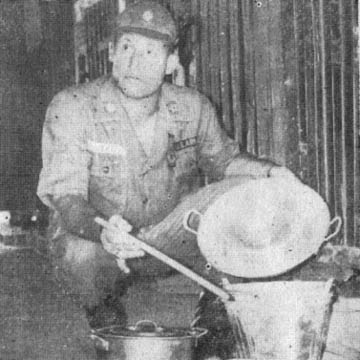 |
FOR THEM - Lt. Col. Robert R. Hicks, 25th civil affairs officer, displays part of a family refugee kit available at the “Helping Hand” Operations Center. The kit consists of a sleeping mat, cup, bowl and chopsticks. (Photo by Sp5 Jose Finklea) |
2nd Bde Chaplain Leads Tho Mo In Its First Mass Since 1961
For the first time in five years, Catholic residents of the village of Tho Mo
attended Mass as a result of the efforts of the 2nd Bn, 27th Inf, “Wolfhounds.”
The battalion arrived in the village recently to conduct a short search and
destroy operation and found a large church. The church was an old dilapidated
building with no seats and a big, Blessed Virgin.
Inquiring how often mass was held, the Wolfhounds learned there had not been
a priest in the area to conduct a service since 1961.
The Wolfhounds immediately contacted Chaplain (Capt.) Clarence A. Olszewski,
2nd Bde Catholic chaplain. Later that night the villagers sat in their church
with their heads bowed in prayer.
The `Tropic Lightning Knockouts’
Cool jazz and hot rock ‘n’ roll is being trucked to every corner of the Cu
Chi base camp as the “Tropic Lightning Knockouts” knock out their sound to
thousands of 25th troops.
The four-man combo, composed of SFC James A. Taylor, 39, of Tucson, Ariz., on
base, SSgt John W. Schank Jr, 26, of Windsor Hill, Conn. on sax, Sp5 Michael L.
Carr, 24, of Shelby, N.C., on piano and Sp5 Robert W. Elsie, 23, of Newark, N.
J., on the drums, has been working together since early May, when they were
asked to play at a cookout by one of the division’s “Wolfhound” battalions.
Since then, these four men have been packing their instruments on their
3/4-ton truck and hitting every unit that invites them.
“We’ve been averaging nearly four performances a week since May,” said
Specialist Carr, “but we really enjoy doing it. The only thing that bothers me
is lugging this piano around.”
Specialist Elsie agreed that it was fun to play for the men because, as he
says, “They really raise the roof with us, and we love it.”
When asked who drove the truck around for the combo, Specialist Carr slowly
raised his hand from behind the piano and said, “I do, especially when it
rains.”
When asked who the leader of the combo was, big. Sgt. Schank’s eves lit up
and he said, “That’s me man.... I’m the hell raiser in the group.”
If one listens to the group for any period of time, he will undoubtedly
discover that all four of them are “hell raisers.” As one of the division
soldiers commented during the combo’s appearance in his company area, “These
cats really know how to put out the sound.”
Page 9 TROPIC LIGHTNING NEWS December 9, 1966
TROPIC FLASHES
![]()
1/14th
Lt. Col. G. Proctor, CO
There was a bit of excitement and a confused soldier at the resupply section
of Hq Co recently. It started when a Coleman lantern was tipped over, setting a
tent on fire.
PFC James D. Van Horn mistook the cries of “fire” and “water” for “mortars!”
He grabbed his steel pot and dashed for the nearest foxhole. In his haste he
tripped over tent ropes and guide wires but finally scrambled safely into a
foxhole.
Feeling secure and more confident inside the shelter, he peered out of the
hole to see what was happening. He spotted the fire and though it had been
started by the enemy mortars. But he didn’t hear any rounds going off.
Very confused, he crawled out of the hole and cautiously made his way to the
fire. It was then he found out truth. The end result was a badly burned tent
and an embarrassed but highly relieved PFC Van Horn.
![]()
2/27th
Lt. Col. H. Shelton, CO
Capt. A. Hinton, IO
“Wolfhounds”
Capt. Charles C. Storey has assumed command of Co C at ceremonies at the
forward command post during Operation “Attleboro.” The captain was previously
the executive officer for Co B.
HHC 2nd Bde
Capt. R, Holt, CO
Capt. W. Goodrich, IO
Heading the long list of recent promotions at HHC recently was Air Force Lt.
Col. Wayne Burrow. The newly promoted lieutenant colonel is the forward air
control officer for the 2nd Bde.
Robert G. Staple received his fourth stripe with an advancement to staff
sergeant. In addition, Lloyde D. Dixon, Tony F. Garcia and George L. Nixon were
promoted to sergeant.
Ten other members of the company turned in their single stripes for
specialist four insignias recently. The company extends hearty congratulations
to all.
![]()
1/5th
Lt. Col. V. Diaz, CO
1st Lt. W. Schwinn, IO
“Bobcats”
Welcome to Capt. Paul McNamara who recently joined the “Bobcat” Battalion.
James Becton and Clarence Shell were recently boosted into a higher income
bracket with their promotion to staff sergeant.
A number of new sergeants were handed their stripes during ceremonies. They
include: Jerry Arnold, Frank Beltram, Patrick Devereams, Billy B. Evans, Harold
Felty, Andrew Kallunki, Russell Richardson and James Wilson.
The unit congratulates men and also the following these new specialist
fives: Dewey Austin, Douglas Fox, Larry J. Nelson and Pete Thomas.
![]()
3/82nd Arty
Maj. C. L. Warren, CO
1st Lt. P. Brown, IO
Two Red Cross girls from Cu Chi brought sparkle back into the battle weary
eyes of the men of the 82nd Arty at Tay Ninh.
Gloria Kral and Kaki Lundy visited the artillerymen and provided an afternoon
of sports questions and games.
The girls set off a “battle” between two groups of soldiers. It was a battle
of wits to see which group could answer the most questions the girls threw at
them.
The ARC volunteers presented a talk on the Olympic Games along with
pictures. A discus throw and basketball game followed.
Gloria works as a program director for ARC while Kaki, who has only been in
Vietnam two months, is recreational aide.
Refugees Get Help
Mr. and Mrs. Refugee have decided to leave the only home they have ever
known, now controlled by the Viet Cong, and move to a place where they can live
under government protection.
What happens to them? Where do they settle? What do they eat? These are
all important questions to the refugee who, in most cases, has little of the
necessities of life.
If the refugee happens to choose an area where 25th Infantry “Tropic
Lightning” Division is working, all his questions will be answered. The
division has many programs setup to help people who are forced to move.
One of the programs is refugee kit distribution. These kits have things that
the refugee will need to help him start his new life. There are kits for each
member of the family, plus a kit of family items.
The kits for each member of the family contain chop sticks, a sleeping mat, a
soup spoon, a rice bowl and a cup. These kits are also supplemented with
articles from the Division’s Helping Hand program, such as clothes, candy and
toys. The family kit has the materials for home-making: Frying pan, a rice
cooker, a cooking spoon, two water buckets and cans of beef stock.
With the kits they have received, the refugees may move to a new hamlet under
government protection to start a new life. At the refugee center and at the new
hamlet they are given medical treatment and health hints. A division doctor
makes weekly visits to the new hamlets to make sure that the people get all
necessary medical care free of charge.
The refugees now have a home, things to work with and a place from the Viet
Cong. The division’s program is not just a free giveaway. It gives the people
a chance to help themselves.
|
THE FAC |
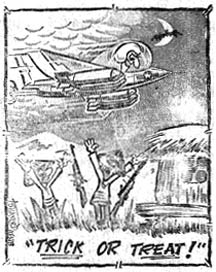 |
4/23 Officers Enjoy Thanksgiving With Viet Officials on Lanikai II
Thanksgiving proved to be a study in Vietnamese-American relations for the
4th Bn, 23rd Inf. “Tomahawks.”
Since early November the “Tomahawks” have been based at Ben Luc in Long An
Province, conducting Operation “Lanikai II.”
The unit’s operations have consisted of civic action projects and tactical
maneuvers closely coordinated with local Vietnamese units. Because of this
close working relationship, the Vietnamese commanders and their American
advisory teams were invited to enjoy the traditional feast with the 25th
Division “Tomahawks.” Over thirty guests, staff officers, and commanders were
in attendance.
A typical statement attesting to the excellence of the food was voiced by Dai
Uy Mo, Ben Luc District Chief, when he said that it was a “Number one meal.”
Lt. Col Louis J. North, Tomahawk commander, explained to the Vietnamese
dignitaries the origin and meaning of Thanksgiving, the first truly American
holiday. Following a Thanksgiving prayer by Chaplain (Capt.) Armand N. Jalbert
the enjoyable task of consuming the the turkey dinner began.
Upon completion of after-dinner coffee, Maj. Giam, 3rd Bn, 50th Regiment
commander Army Republic of Vietnam, made a short speech in which he praised both
American presence and aid to Vietnam. Col. North replied that Americans and
Vietnamese would work and fight together to see peace in his country.
 |
Page 10 TROPIC LIGHTNING NEWS December 9, 1966
Incoming Mortar Rounds;
3/82 Crater Analysis Unit Plots Viet Cong Positions
It is a typical night at Tay Minh, the base camp of the 196th Lt Inf Bde.
The only loud sounds are the familiar rumblings of the howitzers of the 3rd Bn,
82nd Arty, firing spurts of harassing and interdiction rounds at suspected VC
areas.
At 2 p.m. the intermittent rumble is broken by an awakening crack and someone
hollers “Incoming mortars!” Throughout the compound men scramble for their
bunkers.
One of the best ways to fight a mortar attack is to have the artillery bring
fire on the enemy guns, and this is what the 3/82nd did.
But first the artillery needs to know the position from which Charlie is
shooting. If the actual muzzle flashes from the communist tubes are sighted so
much the better. But generally the job of locating the VC emplacement is up to
the crater analysis team of the 3/82nd.
The team is made up of Sgt. Carl Crossley, Sp4 John Polniewicz, and Sp4 Joe
Brown, all of whom work in the fire direction center of the 3/82nd. Sgt
Crossley and Specialist Jones were trained for the job, while Specialist
Polniewicz received on-the-job training.
As soon as the incoming rounds have stopped falling in their immediate area,
the team members leave the safety of their bunkers and begin looking for craters
made by the expended rounds. When they find one, they dig into it and uncover
the tailfins.
Using a compass, they shoot a back azimuth along the tailfin and find the
general direction from which the VC fired.
They then find another crater, dig until they hit tailfins and shoot another
azimuth.
The intersection of the two azimuths is quite close to the enemy mortar
position. From the information obtained by the crater analysis team, the fire
directions center plot the location of Charlie’s tubes and direct accurate
suppressive fire on them.
Once the high explosive rounds of the 82nd Artillery’s 105mm howitzers start
falling in their area the VC break off their firing and run if they are able.
| VC Sees, Briefly
|
Loud Greeting
Mortars Welcome PFC to 196th
PFC Chuck W. Swabby of Fresno, Calif. ran swiftly to a bunker outside his
tent at the 8th Support Battalion’s Replacement Center, 196th Lt Inf Bde, and
waited out a 30-minute mortar attack.
Returning to his bunk to catch up on his interrupted sleep, PFC Swabby said,
“What a crude welcoming. I’ve heard of welcoming celebrations, but none as
noisy as this.”
PFC Swabby, now wide-eyed in wonderment, had just arrived at the Replacement
Detachment the night before the mortar attack, and his first night there was
“quite an experience.”
Being new to the sounds of combat, PFC Swabby never knew what a mortar
sounded like as it flew through the air or while exploding. He literally had to
play it by ear.
“The second night I was here, someone was yelling ‘incoming, incoming.’ and
everyone else started to run outside to the bunker. All I could do was follow,”
said PFC Swabby.
“During the attack I kept thinking that it was a heck of a way to be greeted
to this country,” said PFC Swabby.
“The next few nights I slept with my clothes on, including boots and flack
jacket,” he added. But mortars didn’t come again.
Congressmen Visit 196th Bde
Two Congressmen from the State of Massachusetts - home State of the 196th Lt
Inf Bde - recently visited the Tay Ninh based unit.
Congressmen Edward P. Boland (D-Mass) and Congressman Sulvio A. Conte
(R-Mass) arrived by helicopter and were greeted by Brig. Gen. Richard T.
Knowles, 196th commander, who briefed the two Congressmen on affairs and
activities within the brigade.
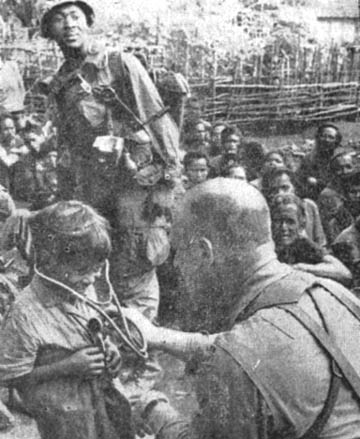 |
HELPING SMILE - Maj. Harold Tippen, 3rd Bde civil affairs officer, jokes with Vietnamese children during a recent civic action visit to Vietnamese villages. |
4/31st PFC Guns Down Cong Medical Supplies
Being a “tunnel rat,” one has to move cautiously and be ready for anything
when searching for the VC in his underground sanctuary.
PFC Richard P. Magnusson of Wochester, Mass., was just that and perhaps a bit
hasty.
PFC Magnusson was on a patrol with Co A, 4th Bn, 31st Inf, 196th Lt Inf Bde,
when a tunnel was discovered in a Viet Cong village. PFC Magnusson was sent
down to investigate the hole.
He went straight down three feet and then started ahead, crawling about four
feet when he discovered the tunnel was L-shaped.
“I quickly pointed my flash light around the corner and caught a quick
glimpse of what looked like a figure crawling away. I fired a shot and hurried
back to the surface to report my find,” he said.
Climbing out of the tunnel before the trail of smoke, PFC Magnusson
approached his platoon leader and excitedly told of how he had shot a Viet Cong.
PFC Magnusson again entered the tunnel with a little anxiety, to see the
results of his actions. Minutes lapsed, then he reappeared from the tunnel with
a faceless expression. He was carrying a bundle of supplies wrapped in a
bulging pair of black pajamas.
Whew! A Few Close Calls for 196th
Close calls seemed the rule rather than the exception for several soldiers of
the 196th Lt Inf Bde during Operation “Attleboro.”
Chaplain (Capt.) Nathaniel Gianatiasio of Bronx, N.Y., out with the 3rd Bn,
21st Inf, stopped briefly to watch Air Force jets blast Viet Gong positions to
his front.
Later, as he got ready to move out, he saw that he had been sitting on a
three-foot poisonous snake for the past half-hour. Capt. Russell DeVries of
Wayland, Mass., Co C commander, came to his rescue and shot the snake.
Not far away, snakes were stirring again.
“We were under fire and I dove into a ready made prone shelter,” said PFC
William E. Chajnowski of Westfield, Mass., Co B, 2nd Bn, 1st Inf. “I felt
movement under me and thought it was a bunch of red ants.”
PFC Chajnowski instead found a two-foot long snake which he promptly cut in
half.
As night fell, Specialist Rudy Petrovsky moved through the darkness to his
position with C/2/1. The next morning, he reached into his ration pack and
found a large tarantula which he killed immediately.
“Grenades were flying everywhere” says Sgt Paul N. Sears of B/2/1. “One
landed next to me and a wounded buddy. It was a dud.”
Sgt. Sears said that in another incident he caught a Viet Cong grenade and
before the shock could register, fired it back to its sender. A moment later, a
VC sniper’s bullet ripped a grenade off his belt, leaving him uninjured and
still fighting.
Over at Co B, 4th Bn, 23rd Inf., PFC Thomas Aubrey of Charleston, W. Va.,
caught his foot on a vine in the dense jungle. He stumbled and fell toward a
deadly punji pit. Luckily, an ammunition box broke his fall, leaving him with
only a pair of broken glasses and a minor leg wound.
Another trooper, PFC Eugene Hazard of Worcester, Mass., C/2/1, spotted a VC
lying on the trail before him. He radioed back to the company for instructions
on what to do with the seemingly dead VC.
Suddenly, the VC raised up and threw a grenade at the soldier. The grenade
fell dead and so did the VC.
It was after dark when Sp4 John M. Doyle of Closter, N.J., Co C, 4/31st, was
pulled into a tight perimeter in the thick jungle.
His position was about six inches from the man next to him. Dawn broke after
a quiet night. Specialist Doyle saw that he and the man next to him had been
sleeping beside a small dnd bomb which could have detonated at the slightest
pressure.
But it was just another close call.
Page 11 TROPIC LIGHTNING NEWS December 9, 1966
2/27th Efforts Prove Successful at Duc Hanh
A short time ago the small village of Duc Hanh B was one of the most highly
Viet Cong influenced villages in Hau Nghia Province. Now, through extensive
development efforts by the 2nd Bn, 27th Inf, “Wolfhounds,” it is a
pro-government community with many modern facilities, including a school,
playground and dispensary.
Before the Wolfhounds arrived the VC roamed the village almost daily on
missions of terror and aggression. Then the battalion began a multi-day
operation there to organize a rehabilitation program. The men worked with the
people during the operation and the battalion civil affairs section visited the
hamlet daily to help the people help themselves.
One of the first projects after winning the people was building barbed-wire
fences and bunkers around the village to keep the VC out. Each house is
protected by a fence and the people take turns manning their perimeter.
As progress was made and word of the American aid got around, nearly 50 new
families moved into Duc Hanh B. The Wolfhounds hired laborers and, with the
help of volunteers, work was begun to build a school and dispensary in two old
buildings.
Both buildings were freshly painted in blue and yellow with bright red
letters identifying them. The school, which consists of two classrooms and two
more planned for the near future, is equipped with new desks and can accommodate
170 children in two sessions. At the head of one classroom stands a large blue
desk with a yellow “Wolfhound” painted on the front.
The dispensary is located across from the school and is staffed by three
cadre nurses who are on call around the clock.
Present operations in the community are the construction of new roads and
drainage systems, fortification of existing structures and military training of
all able-bodied men. The “Tropic Lighting” Division unit is stressing personal
hygiene to the villagers to combat disease.
The Viet Cong are testing the village with almost nightly probes to see if
the people are willing to fight for what they have. Capt. Jack Barham, 30, of
New Orleans, said if the enemy tries to launch an all-out attack on the people
they will be ready. They have made terrific progress in the past and I’m sure
they won’t give it up.
The 2/27th supplied fortification material and technical advice on its
disposition. Capt. Barham said, “When we’re done here and the people can be
assured of security, we’ll move on to another hamlet and start all over.”
“We want to demonstrate to all the people that the Vietnamese government can
provide security, education and health care to those who support it.”
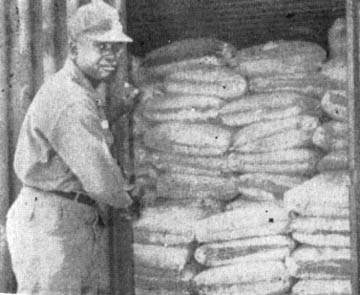 |
RICE - SSgt. Nathaniel Prince displays bags of rice available through “Helping Hand” for Division units to distribute to Vietnamese villagers. |
Know Your Division – Part Two
By Sp5 Wayne Brendt
(Editor’s Note: This is the second in a series of articles about
organizations within the Division which serve you.)
Because someone cares, the people who run the Division’s Replacement
Detachment think they have the best replacement setup in Vietnam.
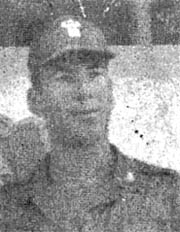 As Capt Charles Rizzo, detachment commander, puts it, “The man who comes in
here has got to feel like he belongs to the Division or he is lost.” The
Atlanta, Ga., career officer continued, “We show him that someone is interested
in him and his well being.”
As Capt Charles Rizzo, detachment commander, puts it, “The man who comes in
here has got to feel like he belongs to the Division or he is lost.” The
Atlanta, Ga., career officer continued, “We show him that someone is interested
in him and his well being.”
Every afternoon as the troop convoy arrives from the 90th Replacement Bn, the
“Tropic Lightning” band strikes up a cheerful tune of welcome for the new
arrivals. A young Red Cross girl serves the incoming soldiers juice and
provides interesting conversation. Also on hand to extend an official greeting
is Brig. Gen. George G. O’Connor, assistant division commander.
Following the arrival ceremonies the personnel are issued mess gear and
blankets and provided quarters for the night.
Immediately after the evening meal a short briefing is given on the mission
of the Division, location, the history and daily activities.
On hand to represent the detachment and move the troops through their
processing is SSgt. Darold E. Priest, the operations sergeant who claims Mineral
Wells, Texe., as home. This Texan, along with the field first sergeant, MSgt.
Lewis Rozier of Lincoln Heights, Ohio, takes the new arrivals through their
necessary administrative work.
All new arrivals get a records check, move on to finance for pay, sign supply
forms and pick up their orders assigning them to units within the Division.
Once administrative work is out of the way, the individual units are contacted
and the new arrival is on his way to his new home.
For those departing the country there is the band to play a farewell. A Red
Cross girl is on hand with coffee and the assistant division commander delivers
a speech thanking the men for their service with the largest Division in
Vietnam.
Continuing to provide the best for the incoming and outgoing personnel, the
replacement detachment will soon move to a new location. The new site will
offer more room for the arrivals, a separate supply and mess, and more overall
comfort.
|
Radio And TV |
| 6:30 | News Headlines Information Please |
8:00 | Gunsmoke |
| 7:00 | Addams Family | 9:00 | Danny Kaye |
| 7:30 | News | 10:00 | The Tonight Show |
|
SATURDAY - Dec 10 |
| 1:30 | News Headlines Social Security Encyclopedia |
4:30 7:00 7:30 |
Football Game Sportsmans Holliday News |
| 2:00 | M-Squad | 8:00 | Ringling Bros. Circus |
| 2:30 | Candid Camera | 9:00 | Hollywood Palace |
| 3:00 | Town and Country | 10:00 | Late Show (Movie) |
| Swingin' Country | |||
| Beverly Hillbillies | |||
| Andy Griffith |
|
SUNDAY - Dec 11 |
| 1:30 | News Headlines | 4:30 | Football Game |
| The Christophers | 7:00 | 20th Century | |
| Sacred Heart | 7:30 | News | |
| 2:00 | Silver Wings | 8:00 | Dick Van Dyke Show |
| 2:30 | Roger Miller | 8:30 | Joey Bishop Show |
| 3:00 | Sunday Matinee (Movie) | 9:00 | Bonanza |
| 4:15 | Sports Scoreboard | 10:00 | John Gary Show |
|
MONDAY - Dec 12 |
| 6:30 | News - Headlines | 8:00 | Combat |
| National Education | 9:00 | Bewitched | |
| 7:00 | The Flintstones | 9:30 | Third Man |
| 7:30 | News | 10:00 | Dean Martin |
|
TUESDAY - Dec 13 |
| 6:30 | News - Headlines | 7:30 | News |
| What's My Line | 8:00 | Rawhide | |
| 7:00 | My Favorite Martial | 9:00 | 12 O'Clock High |
| 10:00 | To Be Announced |
|
WEDNESDAY - Dec 14 |
| 6:30 | News - Headlines | 8:00 | Perry Mason |
| Information Feature | 9:00 | Micky Finn's | |
| 7:00 | Batman (Part 1) | 9:30 | Channel 11 (Movie) |
| 7:30 | News |
|
THURSDAY - Dec 15 |
| 6:30 | News - Headlines | 8:00 | The F.B.I. |
| Wonders of the World | 9:00 | Hazel | |
| 7:00 | Batman (Part 2) | 9:30 | Have Gun Will Travel |
| 7:30 | News | 10:00 | Milton Berle |
|
Saigon 540ke
1330ke Cu Chi |
| 0005 | Be Still and Know | 1220 | USO Show |
| 0007 | Sign Off/On | 1305 | Feature Report |
| 0015 | Night Train | 1330 | Cu Chi Special |
| 0305 | Small World | 1405 | Country Music |
| 0405 | Bill Stewart Show | 1505 | Afternoon Break |
| 0505 | Country Corner | 1705 | Monitor |
| 0600 | Expanded News (10) | 1800 | News and Sports (30) |
| 0610 | Meditations | 1830 | Music By Candlelight |
| 0615 | Dawnbuster | 1905 | Swinging 60's |
| 0705 | Morning Meditations | 2005 | Jazz Concert |
| 0710 | Dawnbuster | 2030 | Night Beat |
| 0830 | Cu Chi Special | 2105 | Aussie News |
| 0905 | Bill Stewart Show | 2110 | Night Beat |
| 1005 | Destination Noon | 2200 | News and Sports (30) |
| 1200 | News & Sports | 2230 | Night Beat |
|
SATURDAY |
| 0005 | Be Still and Know | 1330 | Cu Chi Special |
| 0007 | Sign Off/On | 1355 | Point of Law |
| 0015 | Jazz Show Case | 1400 | Country Music |
| 0105 | Night Train | 1455 | News (5) |
| 0505 | Jim Peters | 1500 | Football |
| 0600 | News (10) | 1705 | Bolero Time |
| 0610 | Meditations | 1800 | News & Sports (30) |
| 0615 | Dawnbuster | 1839 | Candlelight Music |
| 0705 | Mediatations | 1905 | Sammy Davis Show |
| 0710 | Dawnbuster | 2005 | Grand Ole Opry |
| 0905 | Polka Party | 2105 | Aussie News |
| 1005 | Saturday Swing | 2110 | Night Beat |
| 1200 | News and Sports (30) | 2200 | News and Sports (30) |
| 1230 | Navy Hour | 2230 | Night Beat |
| 1255 | World of Money | 2305 | Patty Show |
| 1305 | Feature Report |
|
SUNDAY |
| 0005 | Be Still and Know | 1305 | Panorama |
| 0007 | Sign Off/On | 1455 | News (5) |
| 0015 | Night Train | 1500 | Football |
| 0505 | Jim Ameche | 1705 | Afternoon Music |
| 0600 | News (10) | 1800 | News & Sports (30) |
| 0610 | Morning Music | 1830 | Candlelight Music |
| 0805 | Tabernacle | 1905 | Roger Carroll |
| 0830 | Protestant Hour | 2005 | Footlights, Soundtracks |
| 0905 | Message of Israel | 2105 | Aussie News |
| 0930 | Hour of the Crucified | 2115 | Night Beat |
| 1005 | Morning Music | 2200 | News & Sports (30) |
| 1200 | News and Sports (30) | 2230 | Night Beat |
| 1230 | Army Hour | 2305 | Night Life |
| 1255 | World of Money |
Page 12 TROPIC LIGHTNING NEWS December 9, 1966
Lt. Shelton Speaks On Artillery OCS
Prestige, self-betterment, better pay and the challenge of accepting a more
responsible position are some of the advantages that OCS graduates enjoy,
according to a 1965 graduate of Artillery OCS at Fort Sill, Okla.
1st Lt. Jerry W. Shelton, an artillery forward observer from the 1st Bn, 8th
Arty, presently attached to the 2nd Bn., 27th Inf saw these advantages while
serving as an infantry sergeant. He wanted to make a career of the Army and
decided he could best serve as a commissioned officer.
“The hardest part of OCS was switching from infantry to a new branch. I had
no knowledge of artillery.” But as with all OCS candidates it was the desire to
gain a commission that carried him through the course. “You must have the
desire to take anything that comes along and take orders no matter how
unreasonable they seem,” explained the 24-year-old lieutenant.
Lt. Shelton said that academics are the most important part of the course.
“You must have the ability to grasp a lot in a short time,” he said, pointing
out that the principles of artillery are complex and explained quickly during
classroom sessions.
The Fort Worth, Tex., native said that of the starting 119 members of his
class, only 55 graduated. Some candidates were set back due to medical
reasons. But Lt. Shelton said that lack of motivation was the prime reason for
the over 50 per cent, failures, once again emphasizing the strong desire needed
to graduate from OCS today.
 |
WOMAN’S TOUCH - Men of the 1st Bn, 35th Inf, get their Thanksgiving dinner in the field from Red Cross girl Linnie Stone. (Photo by Sgt. Michael N. Horowitz) |
Red Cross Girl Adds A Touch to Thanksgiving
Thanksgiving 1966 came a day late for the 1st Bn, 35th Inf, this year, but
the men didn’t seem to mind.
On the afternoon of November 25, helicopters arrived at the battalion’s
units, loaded with the traditional dinner and all the trimmings.
Although a steady rain was coming down it didn’t dampen the men’s spirits.
The turkey wasn’t the only thing that cheered the men up. In the serving line
was a new but certainly welcome face.
In an effort to make Thanksgiving in the field seem as close to the real
thing as possible, the feminine touch had been added.
Linnie Stone, a Red Cross girl from San Mateo, Calif., was passing out giblet
dressing and a winning smile.
| GENERALIZING - Lt Gen. Stanley R. Larsen, I Field Force, commander, speaks with Col. James G. Shanahan, commander of the 3rd Brigade Task Force, during a recent visit to the brigade’s forward command post. |
 |
VC Back at Trang Bang
Gunships supporting the 1st Bn., 27th Inf, recently killed three Viet Cong
and captured two others flushed by the advancing infantrymen.
Co C of the “Wolfhound” battalion was on a search and destroy sweep through a
section of Trang Bang District of Hau Nghia Province. They landed by helicopter
in a rice paddie next to a woodline in the heart of a clear afternoon.
As the company began its cautious move through the woods, aerial observers
spotted VC trying to escape from the area. Gunships opened up with machine gun
fire, immediately killing three and quickly convincing two others to surrender.
The “Wolfhounds” have been away from Trang Bang District for the last month
while they were participating in Operation “Attleboro”. When they entered the
woodline, renewed VC activity was evidenced by fresh punji pits and
fortifications.
Casualties
Vietnam loss rate has remained about the same since February. But with
100,000 additional men now serving in the Southeast Asian republic, the casualty
rate per man deployed has declined, U.S. officials point out.
Thanks to:
The 25th Infantry Division Museum for providing the volume of 1966 Tropic
Lightning News,
Ron Leonard, 25th Aviation Battalion for finding and mailing them,
Kirk Ramsey, 2nd Bn., 14th Inf. for creating this page.
This page last modified
01-24-2008
©2008 25th Infantry Division Association. All rights reserved